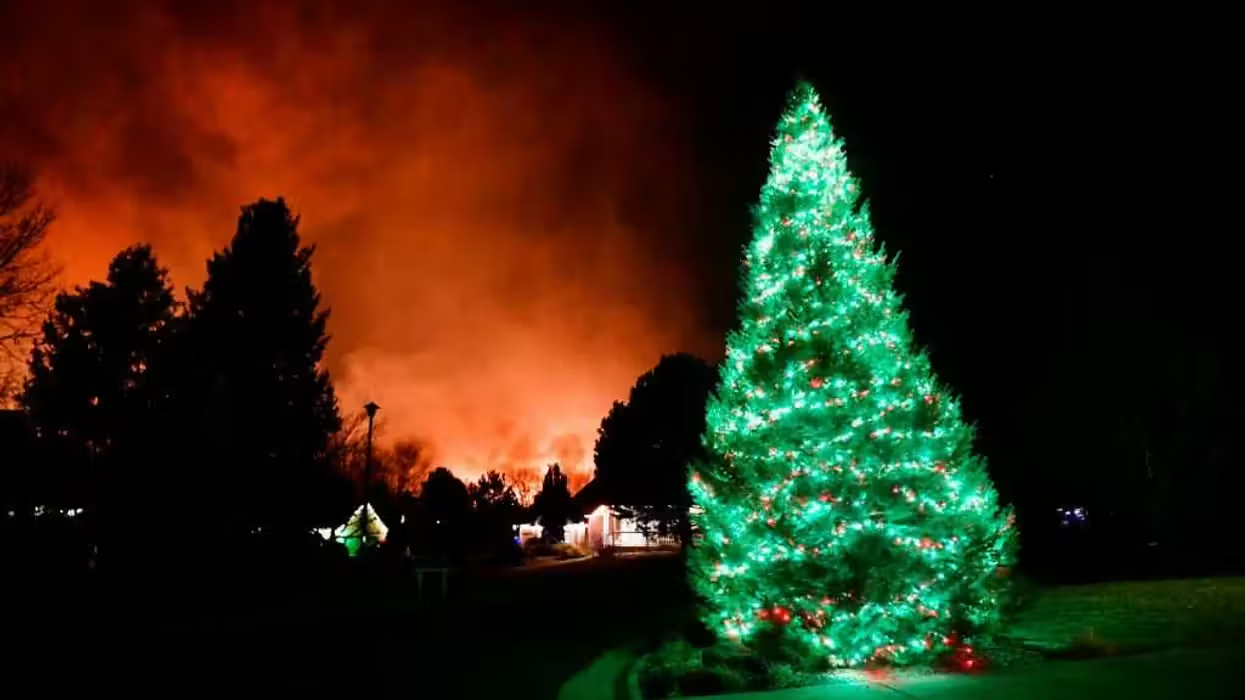
© 2025 Blaze Media LLC. All rights reserved.
Record-Breaking Arctic Ice Melt Blamed on Global Warming and Natural Causes
August 27, 2012
- The National Snow and Ice Data Center revealed Arctic sea ice has shrank to a record level during this 2012 season.
- Scientists attribute this mostly to global warming and cite a trend that this is "an indication that the Arctic sea ice cover is fundamentally changing."
- Scientists also attribute ice melt to more extreme weather further away, such as droughts, flooding and waves of extreme heat and cold.
- A storm earlier this summer did break up some ice that could have helped facilitate the extent of the melt.
- Some question whether a record was set in the melt as a whole.
WASHINGTON (TheBlaze/AP) -- Critical ice in the Arctic Ocean shrank to a record low during this melting season, which scientists say can make weather more extreme far away from the poles.
The National Snow and Ice Data Center reported Monday that the extent of Arctic sea ice melted to 1.58 million square miles and is likely to melt more in the coming weeks. That breaks the old record of 1.61 million square miles set in 2007.

"By itself it's just a number, and occasionally records are going to get set," NSIDC scientist Walt Meier said in a statement. "But in the context of what's happened in the last several years and throughout the satellite record, it's an indication that the Arctic sea ice cover is fundamentally changing."
The North Pole region is an ocean that mostly is crusted at the top with ice. In the winter, the frozen saltwater surface usually extends about 6 million square miles, shrinking in summer and growing back in the fall. Normally sea ice in the Arctic reaches its minimum in mid-September and then starts refreezing. But levels on Sunday shrank 27,000 square miles - about the size of West Virginia - beyond the old record.
Figures are based on satellite records dating back to 1979. The ice center bases its figures on averages calculated over five days.

Data center scientist Ted Scambos said the melt can be blamed mostly on global warming from man-made emissions of greenhouse gases. There are natural factors involved too, including a storm that chewed up a significant amount ice earlier this month. But, he said, dramatic summer sea ice losses in all but one year since 2007, continuous thin ice, and warm air temperatures show a pattern that can only be explained by climate change.
"It really does imply that the Arctic is moving to a new state," said NASA ice systems program scientist Tom Wagner. "The Arctic is changing."
Still, "climate skeptics" have some other thoughts on the melt. Anthony Watts, who maintains the Watts Up With That blog, wrote Monday more on the topic of the storm that broke up some of this ice to facilitate the melt. Watts calls up the NSIDC announcement of the early August storm pointing out what NSIDC wrote of it at the time:
"While this drop coincided with an intense storm over the central Arctic Ocean, it is unclear if the storm prompted the rapid ice loss."
Watts says labeling the effect of the storm on ice "unclear" is "a bit disingenuous."
Watts also points out that several sources, including his own, held the same forecast of 4.5 million kilometers for sea ice on August 5.
"Clearly NSIDC didn’t expect this storm nor its effects, because if they had, their forecast would have been much lower," Watts wrote.
In its announcement earlier this month of the storm, NASA described some of the effects it could have:
Arctic storms such as this one can have a large impact on the sea ice, causing it to melt rapidly through many mechanisms, such as tearing off large swaths of ice and pushing them to warmer sites, churning the ice and making it slushier, or lifting warmer waters from the depths of the Arctic Ocean.“It seems that this storm has detached a large chunk of ice from the main sea ice pack. This could lead to a more serious decay of the summertime ice cover than would have been the case otherwise, even perhaps leading to a new Arctic sea ice minimum,” said Claire Parkinson, a climate scientist with NASA Goddard. “Decades ago, a storm of the same magnitude would have been less likely to have as large an impact on the sea ice, because at that time the ice cover was thicker and more expansive.”
In a second post, Watts goes on to say that he has found indications that no significant record was set in the first place. He cites a couple of NSIDC's other measuring sensors finding no record was set:
So who to believe? It depends on the method, and who thinks their method is most representative of reality. Measuring sea ice via satellite, especially when you use a single passive sensor system that has been show in the past to have degradation problems and outright failure (which I was told weren’t worth mentioning until they discovered I was right and pulled the plug) might be a case of putting all your eggs in one basket. I suspect that at some point, we’ll see a new basket that maybe isn’t so worn, but for now, the old basket provides a comfort for those who relish new records, even though those records may be virtual.
Check out Watt's full post for more of his reasoning here.
Still, NASA chief scientist Waleed Abdalati calls the melt a "substantial step" to the day when there will be no significant sea ice in the Arctic.
"Why do we care?," Abdalati, an ice scientist, asked. "This ice has been an important factor in determining the climate and weather conditions under which modern civilization has evolved."

Scientists sometimes call the Arctic the world's refrigerator and this is like leaving the fridge door open, Scambos said.
"This is kind of a knob on global weather," Wagner said. "We don't know the impact yet" of fiddling with it.
Scientists say Arctic sea ice helps moderate temperatures further south in the winter and summer. A study earlier this year in the peer-reviewed journal Geophysical Research Letters linked some of the factors behind Arctic sea ice loss to higher probabilities of extreme weather "such as drought, flooding, cold spells and heat waves."
Scientists also say sea ice is crucial for polar bears and other animals.
Wagner said the changes in Arctic sea ice fits with glacier loss in Alaska and Canada and ice loss in Greenland. Earlier this summer, NASA satellites reported a dramatic melt in Greenland, where nearly every part of its massive ice sheet started melting. It is an event that last happened in 1889 but a NASA scientist said it occurs an average of every 150 years, which would be this more recent melt close to on target.
Ohio State University ice scientist Jason Box has been monitoring Greenland, where he said temperatures have sometimes been 9 to 18 degrees warmer than normal this summer and the ice is reflecting far less heat - and thus absorbing more energy - than ever before.
Global warming physics for years has been saying if greenhouse gases are causing climate change, the Arctic will feel it first with loss of sea ice and melt in snow and ice on land, Box said.
"We're in a declining trend because the Earth is getting warmer," Scambos said. "It's going to continue to be a series of shrinking ice extents year by year... We're not going back."
This story has been updated to include more information.
Want to leave a tip?
We answer to you. Help keep our content free of advertisers and big tech censorship by leaving a tip today.
Want to join the conversation?
Already a subscriber?
more stories
Sign up for the Blaze newsletter
By signing up, you agree to our Privacy Policy and Terms of Use, and agree to receive content that may sometimes include advertisements. You may opt out at any time.
Related Content
© 2025 Blaze Media LLC. All rights reserved.
Get the stories that matter most delivered directly to your inbox.
By signing up, you agree to our Privacy Policy and Terms of Use, and agree to receive content that may sometimes include advertisements. You may opt out at any time.






